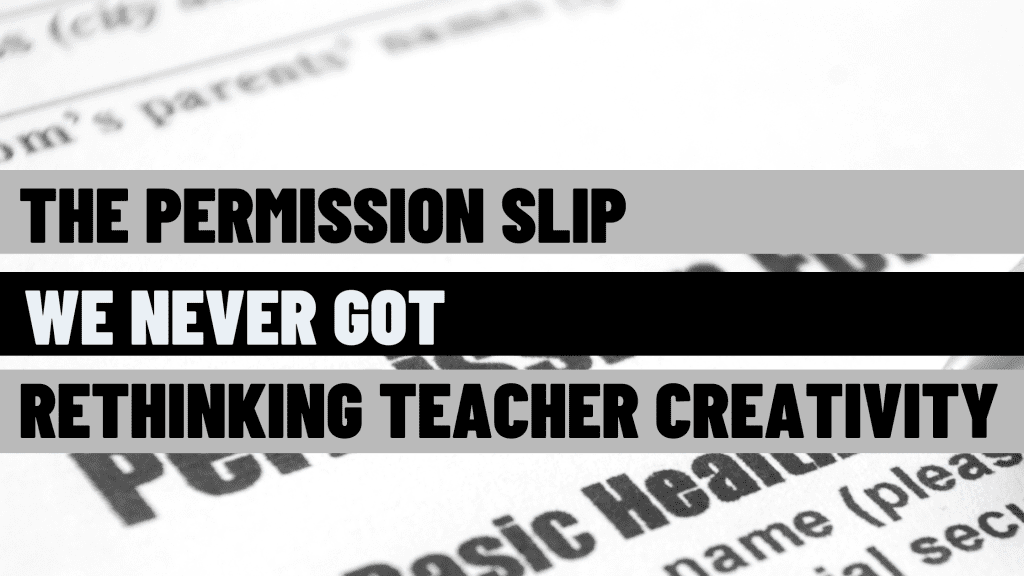What if every new teaching initiative didn’t mean starting from scratch?
Every year brings new methodologies, frameworks, and must-try strategies. And too often, the message is clear: Your individual teacher creativity is irrelevant. Set aside what you know. Start fresh. Implement this exactly as shown.
But here’s what those initiatives often miss: You’re not a blank slate. You bring years of developed expertise, deep understanding of how learning works, and sophisticated knowledge from multiple domains. You have teacher creativity locked in, but you haven’t been given the permission to use it.

Table of Contents
The Implementation Paradox
Think about the last major initiative you were asked to implement. The message was probably:
- Follow these exact steps
- Use these specific strategies
- Replicate this particular approach
- Start fresh with this new method
The assumption? Your existing expertise might actually get in the way of “proper” implementation.
But what if your developed understanding is exactly what could make that initiative work better?
The Teacher Creativity Paradox
We say we want creative teaching and teachers. But look at what we actually celebrate in education:
- Perfectly executed lesson plans
- Pinterest-worthy classroom displays
- Instagram-ready activities
- Standard approaches that feel “safe”
Think about your most successful teaching moments. Chances are, they drew not just on teaching knowledge, but on deep understanding you’ve developed in other areas. Maybe you:
- Recognized patterns others missed because of your experience analyzing complex systems
- Built student engagement through insights gained from years of understanding how stories work
- Created effective structures based on your sophisticated grasp of how people develop skills
- Designed learning experiences drawing from your deep knowledge of how communities build understanding
These aren’t just random skills or interests. They’re sophisticated frameworks for understanding how learning works, built through years of experience both in and out of the classroom.
Real innovation doesn’t come from a box, but instead it emerges from:
- Bringing natural interests into teaching
- Seeing connections across domains
- Understanding patterns in different contexts
- Applying insights from various fields
The best teachers don’t succeed by ignoring their developed expertise when new initiatives arrive. They succeed by understanding how their unique combinations of knowledge and experience can enhance any approach.
So what does real teacher creativity look like?
Making Your Expertise Work
When you truly understand your teaching style, you can:
Adapt Initiatives Systematically
- Identify natural connection points
- Engineer effective modifications
- Build sustainable implementation
- Create clear growth paths
Choose Growth Areas Strategically
- Target high-impact stretches
- Build from existing strengths
- Develop systematic support
- Track meaningful progress
Make Better Implementation Decisions
- Evaluate approaches objectively
- Modify strategies effectively
- Build reliable systems
- Create sustainable practices
From Initiative to Integration
Instead of starting fresh each time, apply your teacher creativity to:
1. Recognize Patterns
- What’s actually new here?
- What principles already work?
- Where does expertise apply?
- How do systems connect?
2. Engineer Adaptations
- What needs modification?
- How do strengths enhance this?
- Where can systems integrate?
- What supports success?
- How do we make this last?
- What structures support growth?
- Where do we need flexibility?
- How do we protect progress?
From Permission to Practice
The shift to owning your creative teacher title isn’t about adding more to your teaching. It’s about:
- Recognizing your natural strengths
- Understanding your authentic perspectives
- Building from genuine interests
- Creating sustainable innovation
Because real teacher creativity isn’t about performance. It’s about bringing your whole self to teaching.
Moving Forward
You’ve developed expertise through years of experience both in and outside the classroom. The key isn’t starting fresh with each new initiative – it’s understanding how to leverage your unique combination of knowledge and experience more systematically.
Start by asking:
- Where do my interests offer insight?
- What strengths am I not fully using?
- What patterns define my most effective teaching?
- How has experience shaped my understanding?
Then begin bringing those perspectives into your teaching systematically.
Ready to map your developed expertise more systematically? Take the Teaching Style Quiz to start understanding the teacher creativity patterns that could make every initiative work better in your classroom.



